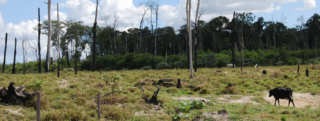- Resources
- New tactics to meet 2020 deforestation goals
Resources
New tactics to meet 2020 deforestation goals
Published: August 21, 2018 by Katie Anderson
Over the last 15 years, an impressive number of companies have set ambitious forest targets in their supply chains. As of September 2017, more than 470 companies in the food and agriculture sector have pledged to eliminate deforestation from their supply chains. The Consumer Goods Forum a group of 400 global companies with over $3.1 trillion in assets for example, pledged to achieve zero net deforestation by 2020.

2020 may have seemed like a long way off when they were planning, but with less than 20 months to go, it’s not surprising that companies and NGOs are looking for ways to drive progress at a faster rate. Despite the fact that companies continue to make commitments and implement those pledges, progress remains slow. Many of these commitments were built on the idea that purchasing certified deforestation-free commodities would materially reduce forest loss the theory being that if enough companies signed on, commodity-driven deforestation would stop. However, the reality is that even as commitments are at an all-time high, deforestation rates are still rising. The initial theory of change focused on certifications seems to be insufficient to solve deforestation.

So, as 2020 approaches, what new theories of victory will companies need to utilize in order to meet their 2020 sustainability targets and ensure that forest loss halts for good? To answer this question, leading companies, have begun exploring and implementing innovative ideas to drive deforestation reduction. These new tactics include:
- Radical transparency: In February, Unilever was the first consumer goods company to publicaly disclose the palm oil mills and plantations from which it sources. Total transparency allows full accountability because the public can see all activity associated with Unilever’s palm supply chain.
- New land-based targets: Mars, Inc.’s Sustainable in a Generation Plan includes a goal to hold flat the total land area associated with its supply chain. This ambitious goal is built on the science of planetary boundaries. Per Mars’ website: “Science says no more than 15 percent of land globally should be cultivated for crops. Today, the planet is right on the cusp of this threshold with 13 percent of land being cultivated as of 2010.”
- Jurisdictional approaches: Companies such as Unilever, Marks & Spencer, Walmart, Olam, and Tesco have stated support for jurisdictional or landscape-scale approaches to deforestation reductions, reflecting a shift from a supply chain specific approach to deforestation to a more comprehensive, multi-stakeholder approach.
EDF believes that the last tactic jurisdictional approaches is a game changer for companies striving to meet 2020 deforestation goals. Through the jurisdictional approach, governments and companies, alongside NGOs, local communities, producers, and other stakeholders work together to promote sustainable development across an entire landscape. Governments, intent on increasing agricultural production while keeping forests standing, develop ambitious plans and policies to conserve forests that can complement the deforestation mitigation efforts of companies. In turn, companies aiming to achieve their sustainability targets can help create viable growth opportunities for the region by participating in the jurisdictional process, providing technical or financial support, or agreeing to source from the region.
One promising jurisdiction that is ready for corporate engagement is Mato Grosso, Brazil. This agricultural powerhouse produces nearly 30 percent of Brazil’s soy and has the largest cattle herd in Brazil, with more than 30 million cattle. From 2004 to 2014, Mato Grosso demonstrated that it is possible to reduce deforestation while increasing agricultural productivity. To ensure a continued increase in agricultural productivity and strong forest protection, Mato Grosso’s government created the Produce, Conserve and Include (PCI) strategy.
This leading jurisdictional approach aims to increase productivity across the state, all while maintaining native vegetation cover and reducing deforestation. The PCI’s ambitious goals add up to huge environmental benefits over six gigatons of avoided emissions by 2030. Recognizing that meeting these aggressive goals requires a multi-stakeholder effort, the PCI brings together government agencies, civil society, producer groups and companies to achieve its goals.
As more jurisdictional approaches like the PCI are developed and implemented, greater corporate involvement will be essential. Here are five ways companies can engage in jurisdictional approaches:
- Identify potential jurisdictions with which to engage, considering environmental performance.
- Engage in the multi-stakeholder process in these jurisdictions.
- Provide technical or financial support to on-the-ground projects that drive toward the broader jurisdiction’s goals.
- Commit to source from a jurisdiction aiming to meet sustainability goals as a way to send the signal that sustainable development goals can drive access to markets.
- Voice support for jurisdictional approaches in deforestation communications and policies.
As companies continue to think about how they can meet 2020 forest goals, EDF encourages companies to expand the arsenal of tactics they use. By engaging in cross-sectoral jurisdictional approaches, companies can drive landscape-wide forest protection and provide proof of concept for a viable deforestation reduction approach.

